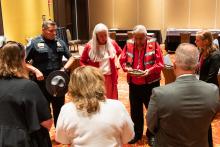Archival Notice
This is an archive page that is no longer being updated. It may contain outdated information and links may no longer function as originally intended.
It seems prescient that Juanita Adams' Lakota name, Omani Wi, means "woman on the longest walk." Because her last journey took 30 years—until she reached her final resting place with her family, in South Dakota's Badlands on the Pine Ridge Reservation.
A member of the Oglala Lakota Tribe, Juanita was 19 years old when she left Pine Ridge in 1978 to join the American Indian Movement's "Longest Walk." The five-month trek from San Francisco to Washington, D.C., protested threats to tribal lands and water rights. She was never heard from again.
Some two years after Juanita left, skeletal remains of an adult woman were found near a highway in Hall County, Georgia. A forensic examination revealed that the remains contained a prosthetic right eye and evidence of injuries that had likely occurred years before her death. Despite the work of investigators and agencies, the woman's identity and the circumstances of her disappearance remained unknown.
A breakthrough finally came in 2010. When law enforcement posted a forensic reconstruction of the woman's face on a missing persons website, a family member recognized Juanita and was able to identify her glass eye and other injuries from a car accident. The website passed the tip to the National Missing and Unidentified Persons System(NamUs), a powerful repository and resource center funded and administered by the Office of Justice Programs' National Institute of Justice. NamUs worked with a forensic laboratory to obtain a DNA sample from Juanita's sister and to submit it to the FBI's Combined Index Database System, or CODIS.
Within six months, following DNA analysis that included a sample from the remains, NamUs helped confirm that Juanita had been found. Her cause of death remains a mystery, as does what took her to Georgia. But finally she could return home.
Sadly, Juanita's is not an isolated story. Influenced in part by a history of collective trauma, a disproportionate rate of violence occurs in Indian country or affects American Indians and Alaska Natives. According to a key 2016 study funded by NIJ, more than four in five AI/AN adults have experienced some form of violence in their lifetime, and more than half of all AI/AN women have experienced violence from an intimate partner.
High levels of domestic violence and human trafficking, primarily targeting women and children, are common. And hundreds of Native Americans have simply vanished, leaving no trace of their bodies or of the crime that victimized them.
Multiple factors complicate solving the crimes, including the extreme remoteness of many communities; lack of consistent, thorough reporting of murders and missing persons; shortage of on-the-ground law enforcement; deficits in training, forensics equipment and personnel to aid investigations; lack of technology and infrastructure; and tangled jurisdictional boundaries.
Addressing the problem of AI/AN missing persons is a top priority for OJP—and NamUs is an effective tool to help solve their disappearances or murders. Since 2007, more than 18,000 missing persons cases across the country have been resolved after they were reported in NamUs. But the system remains seriously underused by AI/AN communities. NamUs currently lists 381 cases of missing persons, 125 of unidentified persons, and 14 of unclaimed persons thought to be from Indian country.
To increase its awareness and use among tribal members, NamUs held a Missing Persons Day, which is taking place just before the annual tribal consultation of the Office of Violence Against Women, August 21-22 in New Buffalo, Michigan, and brings together tribal leaders from across the country.
On Missing Persons Day, American Indian family members had the opportunity to report the disappearance of their loved one to law enforcement and register the case in NamUs. They could also provide a DNA sample—through a simple swab inside the cheek—that could help find connections between missing persons and remains that have been found but not identified. Through CODIS, investigators and labs can exchange and compare the sample to DNA from other crimes.
Since 2018, new capabilities enable investigators to collect, search and analyze entries from tribal law enforcement agencies registered for and using NamUs. Consequently, NamUs officials are reaching out to tribal law enforcement, urging them to submit missing persons and unidentified remains cases, because increasing the number of AI/AN cases in the database will dramatically increase the individuals located and human remains identified. NamUs is also accessible to the public, providing a forum for them to provide leads and search for missing loved ones.
These efforts seem to be working. Currently, NamUs has helped resolve 51 cases of missing persons, which has more than tripled in about two years, and 20 cases of unidentified persons involving American Indians or Alaska Natives.
No family should have to live wondering if their loved one is alive or dead. Through NamUs, OJP is helping to bring the missing home.
Attorney General William Barr has raised the profile of the public safety crisis in Indian Country. Katie Sullivan, now OJP's Principal Deputy Assistant Attorney General, accompanied Mr. Barr on a June trip to Alaska Native villages. Soon after, the Justice Department announced emergency measures to increase personnel, grants and training for tribal, state and federal law enforcement and victim services.




